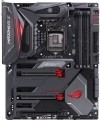Metal backplate
The presence
of a metal backplate in the design of the motherboard.
The backplate is a special plate located on the back side of the board (that is, on the opposite side from the connection slots). This feature is typical mainly for advanced "motherboards" designed for powerful systems: individual components of such systems (especially cooling) can be very heavy, and installing them directly on the board would be fraught with damage to it. And the metal backplate avoids this: it plays the role of an additional support that removes the main load from the motherboard. At the same time, such a plate is usually made thick and elastic enough to transfer even a very significant weight of components without consequences.
USB 2.0
The number of USB 2.0 connectors provided on the motherboard.
USB connectors (all versions) are used to connect to the "motherboard" USB ports located on the front panel of the case. With a special cable, such a port is connected to the connector, while one connector, usually, works with only one port. In other words, the number of connectors on the motherboard corresponds to the maximum number of front USB connectors that can be used with it.
Specifically, USB 2.0 is the oldest version widely used nowadays. It provides data transfer rates up to 480 Mbps, is considered obsolete and is gradually being replaced by more advanced standards, primarily USB 3.2 gen1 (formerly USB 3.0). Nevertheless, a lot of peripherals are still being produced under the USB 2.0 connector: the capabilities of this interface are quite enough for most devices that do not require a high connection speed.
Wi-Fi
USB 2.0
The number of USB 2.0 connectors installed on the back of the motherboard.
Recall that USB is the most popular modern connector for connecting various external peripherals — from keyboards and mice to specialized equipment. And USB 2.0 is the oldest version of this interface that is relevant today; it is noticeably inferior to the newer USB 3.2 both in terms of speed (up to 480 Mbps), and in terms of power supply and additional functionality. On the other hand, even such characteristics are often enough for undemanding peripherals (like the same keyboards / mice); and devices of newer versions can be connected to the connectors of this standard — there would be enough power supply. So this version of USB is still found in modern motherboards, although there are fewer and fewer new models with USB 2.0 connectors.
Note that in addition to the connectors on the rear panel, connectors on the board itself (more precisely, ports on the PC case connected to such connectors) can also provide a USB connection. See below for more on this.
BIOS FlashBack
Motherboards that support
BIOS FlashBack provide the ability to flash or restore the BIOS without a processor, video card or memory. The main purpose of the function is to provide users with the ability to update the BIOS in cases where the current version is incompatible with the installed processor or other computer components, which may lead to the inability to start the system. As a rule, the motherboard provides for this a USB connector for a flash drive and a special button (usually labeled BIOS Flashback) - pressing it initiates the update process.
On a separate line, we note that the BIOS FlashBack function can be called differently depending on the manufacturer: in motherboards from ASRock and Asus - BIOS FlashBack, from Gigabyte - Q-Flash Plus, from MSI - Flash BIOS, etc.
Clear CMOS
Jumper on the motherboard to reset the BIOS memory to factory settings. Its presence will come in handy when a computer malfunctions - when it simply does not turn on or freezes at the startup stage, while it is not possible to enter the BIOS and reset the settings through it.
Note that the
Clear CMOS jumper is often designated by other similar abbreviations: clr cmos, clear cmos jumper, Clear RTC, etc.

